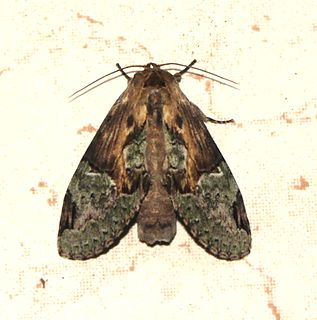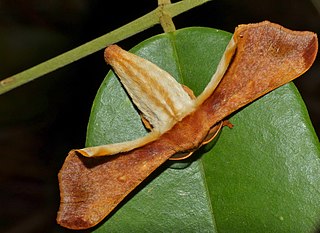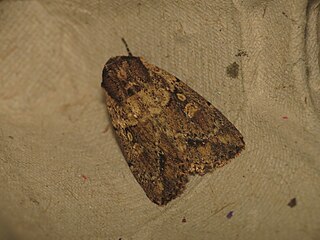Related Research Articles
Mantala is a monotypic moth genus in the subfamily Arctiinae. Its single species, Mantala tineoides, is found on Borneo. Both the genus and the species were first described by Francis Walker in 1862. The habitat consists of lowland and lower montane forests.
Tampea is a genus of moths in the subfamily Arctiinae.
Batracharta is a genus of moths of the family Erebidae. The genus was erected by Francis Walker in 1862.
Savara is a genus of moths of the family Erebidae. The genus was erected by Francis Walker in 1862.

Chadisra bipars is a moth of the family Notodontidae. It was described by Francis Walker in 1862 and is found in the Indomalayan realm.

Collix ghosha is a moth in the family Geometridae. It was described by Francis Walker in 1862. It is found in the Indo-Australian tropics, from the Indian subregion, Sri Lanka to Queensland, Japan and New Caledonia.

Eugoa trifascia is a lichen moth in the family Erebidae, subfamily Arctiinae. The species was first described by Francis Walker in 1862. It is found on Peninsular Malaysia and Borneo. The habitat consists of lowland to lower montane forests.
Tampea accepta is a moth of the subfamily Arctiinae first described by Arthur Gardiner Butler in 1877. It is found on Borneo, the Philippines, Sangihe, Sulawesi, Sula Mangoli and the Kei Islands. The habitat consists of lowland forests.
Tampea metaphaeola is a moth of the subfamily Arctiinae first described by George Hampson in 1900. It is found on Borneo, Sulawesi and Sangir.
Lyclene distributa is a moth of the family Erebidae first described by Francis Walker in 1862. It is found in Borneo, Peninsular Malaysia and Sumatra.
Nishada rotundipennis is a moth of the family Erebidae first described by Francis Walker in 1862. It is found on Borneo and Peninsular Malaysia and in Myanmar and the north-eastern Himalayas. The habitat consists of forests.
Nishada syntomioides is a moth of the family Erebidae first described by Francis Walker in 1862. It is found on Borneo. The habitat consists of lowland forests.
Tampea nodosa is a moth in the subfamily Arctiinae. It was described by Jeremy Daniel Holloway in 2001. It is found on Borneo. The habitat consists of lower montane forests and alluvial forests.
Teulisna chiloides is a moth in the family Erebidae. It was described by Francis Walker in 1862. It is found on Peninsular Malaysia, Sumatra, Borneo, Sulawesi and Sumbawa. It has also been recorded from Queensland, Australia. The habitat consists of lowland dipterocarp forests, alluvial forests and lower montane forests.

Gunda ochracea is a species of moth in the family Bombycidae. It was described by Francis Walker in 1862. It is found in the Indian subregion and from South-east Asia to Sumatra, Borneo and the Philippines. The habitat consists of various lowland forest types.
Sewa orbiferata is a moth in the family Drepanidae. It was described by Francis Walker in 1862. It is found in northern India, northern Myanmar, Malaysia, Borneo, Java and China.
Nygmia xanthomela is a moth of the family Erebidae first described by Francis Walker in 1862. It is found in Sri Lanka, Borneo, Java, Sumatra and Peninsular Malaysia.
Callopistria thalpophiloides is a moth of the family Noctuidae first described by Francis Walker in 1862. It is found in the Indian subregion, Sri Lanka, Sundaland, China, Taiwan, Philippines, Sulawesi and New Guinea.

Mythimna reversa is a moth of the family Noctuidae first described by Moore in 1884. It is found in the Indian subregion, Sri Lanka, Borneo, the Philippines, Hong Kong, Malaysia and Australia.

Earias cupreoviridis, called the cupreous bollworm as a larva, is a moth of the family Nolidae. The species was first described by Francis Walker in 1862. It is found in African countries like Botswana, the Democratic Republic of the Congo, Eritrea, Ethiopia, the Gambia, Kenya, Nigeria, Sierra Leone, South Africa, Togo, Uganda, Zimbabwe to Asian countries like India, Sri Lanka, China, Japan, Korea, Philippines, Indonesia and Hong Kong.
References
- ↑ Savela, Markku. "Tampea reversa (Walker, 1862)". Lepidoptera and Some Other Life Forms. Retrieved February 8, 2018.
- ↑ The Moths of Borneo
- Pitkin, Brian & Jenkins, Paul. "Search results Family: Arctiidae". Butterflies and Moths of the World. Natural History Museum, London.
| This Lithosiini-related article is a stub. You can help Wikipedia by expanding it. |